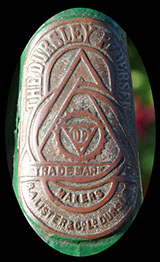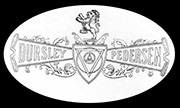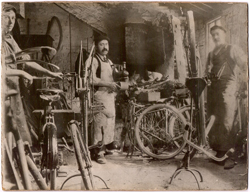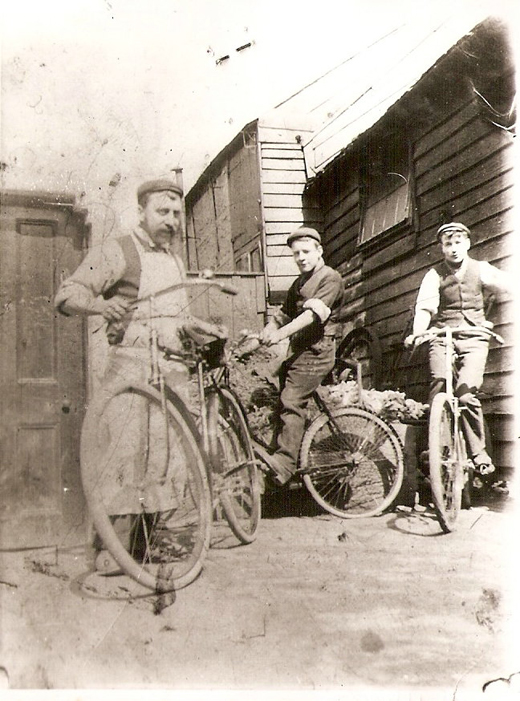

I may say that after 2000 miles on the Cantilever I would not return to the Diamond Frame for anything. There is no comparison between the two. I can take hills quite easily that are considered unrideable by strong riders. I find side slip has no terrors for me now, on the Dursley Pedersen.
– C.J. Noyes, Eccles Old Rd, Manchester; 1910 Dursley Pedersen Catalogue
In recent years, the Dursley Pedersen bicycle has been elevated to iconic status. Good examples are now hard to find …and prices have appreciated beyond the budget of the casual vintage rider and collector. Although some enthusiasts may complain, this situation is, of course, an accurate reflection of their original position in the bicycle market …because 100 years ago they were also beyond the budget of all but the richest cyclists. Just as exclusive motor cars have always been the preserve of aristocracy, this is, of course, an essential part of their appeal. For under £5000 today, one is able to own and ride a vehicle that would only have been ridden 107 years ago by the richest members of British society.


1909 Dursley Pedersen Cantilever Standard
With the Pedersen Frictionless 3-Speed Gear
Gentlemen’s Size 4 (Equivalent to a 22″ Diamond Frame)
28″ Wheels
Frame No 5035
(Now sold)


This Pedersen enjoys excellent provenance – rare for a vintage bicycle – as it was in the ownership of the Pearson family for most of its lifetime. Pearsons is acknowledged by the Guinness Book of Records as the world’s oldest cycle shop. My friend Ray bought it from Pearsons in 2002. It retains its Pearsons shop label, below.

The Dursley Pedersen was restored some years prior to Ray’s purchase (I would estimate in the 1980s), and the paint is now chipped through years of use. There’s no rust on the metalwork and the frame is sound. The tops of the original handlebar grips are split (a common issue with inverted levers when brake linkage is replaced). The saddle and nickel wheels appear to have been replaced at that time. I can see a few washers that may be newer, but the nuts have round heads and look original to the bike. The head lock functions perfectly. The Pedersen Frictionless 3-Speed Gear works fine, and it is in good mechanical condition. This is a very original machine, deserves a clean and a polish as befitting of its status in the world of vintage bicycles, and is ready to ride.
Dursley Pedersen seats look high, but once the rider is mounted, they sink around 2 inches. This size frame is suitable for someone with an inner leg measurement around 31″ – 32″ and height around 5′ 7″ to 5′ 9″.






PEARSON’S CYCLES
High St, Sutton, Surrey

Pearson Cycles, established in 1860, is the world’s oldest bike shop. The shop has remained in the family and now the fifth generation of Pearsons run the business. The first shop was launched by their great great grandfather, Thomas Pearson.
Born in 1831, Thomas Pearson was the son of a Street Cobham farmer named William Pearson, whose father before him, Henry Pearson, had been a wheelwright at Church Cobham. He had married Mary (n. Lee) of the same age from Weybridge after serving an apprenticeship at Shoesmith and Lee’s blacksmiths in Street Cobham, whose building remains there today as a simple shop, just adjacent to the town’s wood merchants.
In 1860, Tom Pearson moved to Sutton from Cobham and set up a blacksmiths in High Street, Sutton at the current shop site. Sutton and its High Street had developed as a stop-off point for horse drawn trade vehicles travelling between London and south coast ports; however, its steep thoroughfare proved difficult for heavy loads. To help get these heavy loads up the steep hill, a strong horse was often hired from the stables at the Cock Hotel, so the services of a blacksmith were often called upon.
Tom Pearson, then 29, brought with him four children, and he and Mary had five more children. The premises were rented from the local miller and baker, Dendy Napper. The structure of the building remains virtually unchanged since. They lived above the smithy in two rooms (now one showroom), but when the older children grew up, they slept in the hayloft of the wooden stable behind the shop (now the Pro Shop). Life wasn’t always easy for the children, the boys complained of being bitten by the rats that shared their barn dormitory and water was pumped from a well at the top of the yard to supply water for the family as well as the business. Despite all this, all nine children lived to a ripe old age.
The sound of the working smithy was familiar back then: the rhythmical ring of the hammer – three strokes on the anvil to one on hot iron – echoing along the high street. Tom would have felt the heat from the blazing forge fire while he pumped leather bellows, smelling the pungent smoke from the horses hooves as they were shod, as he dutifully served the community by making and repairing anything made from metal. Children, who bowled iron hoops up and down the road, brought them to Tom to mend at a ha’penny a time.

Trade progressed in the smithy and the second youngest of the children, Harry Pearson, took over from his father. The bicycle had become an established means of transport by the late 1800s and their repair and maintenance represented a growing proportion of trade. Amongst the collection of old handmade tools that were used by this first generation, is a hot roller for repairing tyres and tubes. When Tom died in 1901, aged 70, he owned two other smithy businesses, one in George Street and the other in Chandler’s Yard. These were presumably run by other members of the family, but were sold off for £100 and £200 respectively. By this time, the cycle business was well under way – as the accounts can attest to – with the majority of value in the firm being in cycle stock. It was around this time that Harry finally made a decisive move – thank goodness – to turn his efforts entirely towards bicycles. The smithy had always repaired bicycles and as the popularity of horse drawn travel was dwindling, it proved too good an opportunity to miss.

HARRY PEARSON, 1906
By the start of the new century, Harry was supplying Sunbeam, Swift, Triumph and Pearson’s own model, the ”Endeavour’, which he manufactured himself, the name being suggested by his first customer. He used his smithy skills, gleaned from his father, to braze the frames on the old forge with hand operated bellows and these frames were then carried, by cycle, by the shop boy, namely a Master Carter, over to Croydon Works for plating and enamelling. He also repaired bassinets, and riding lessons were given at one shilling for half an hour: cycling came in with such an impact in 1890 that most adults could not ride.

In 1916, Harry purchased the shop from the existing owner, Mr. Napper, which was of a great relief to the family as they had no real lease up until then. Harry and his wife, Mary, had three children and the two boys, Arthur and Len, both followed their father into the business. Harry didn’t take a single day’s holiday for the whole of his working life; he often continued late into the evening to complete his day’s work, and was at his bench only hours before his death in 1946.

















DURSLEY PEDERSEN FRAME SIZES
SIZE 1………………. 27 1/2″ Inside Leg
SIZE 2…………………… 29″ Inside Leg
SIZE 3…………………… 30″ Inside Leg
SIZE 4………………. 31 1/2″ Inside Leg
SIZE 5…………………… 33″ Inside Leg
SIZE 6…………………… 34″ Inside Leg
SIZE 7…………………… 35″ Inside Leg
SIZE 8…………………… 38″ Inside Leg

















DURSLEY PEDERSEN SADDLE





THE PEDERSEN FRICTIONLESS GEAR





Pearson’s history – http://www.pearsoncycles.co.uk/heritage/
– http://www.telegraph.co.uk/news/uknews/8769189/The-UKs-oldest-bike-shop-looks-to-the-future.html





















































